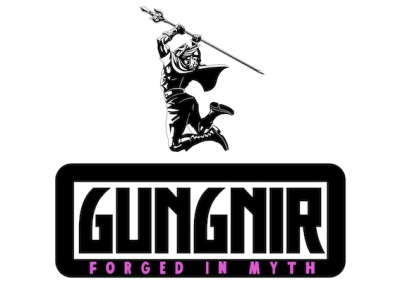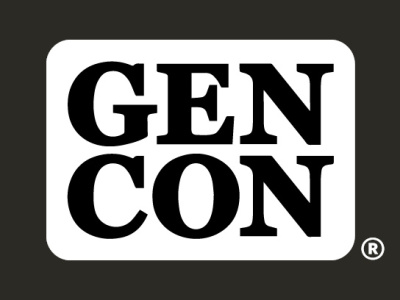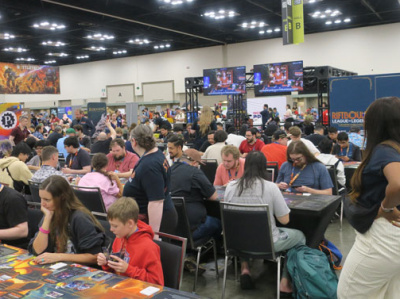I’d like to thank Marco and the Board of Directors for inviting me to speak here at the ComicsPRO annual membership meeting. There’s a pretty big part of me that is surprised by this: I’ve got some small reputation as a Bomb Thrower. To therefore be invited up, as the first speaker of the meeting, tells me that there’s trouble in periodicals and the Direct Market.
National sales are very poor – there are comics in the national top 100 that aren’t even selling twenty thousand copies. A significant number of stores have closed — perhaps as many as 10% of outlets.
And, as far as I know, every person in this room is working significantly harder — with many of us barely hanging on as our margins have cratered.
So the remit that was given to me was to lay out some blame.
I am happy to do that; in fact, I’m pretty OK at it. But before I do that, I actually want to start off by saying that I believe that the Direct Market is one of the greatest creations in the history of the intersection of Art & Commerce!
Look: we are a self-created market of entrepreneurs – folks who wear the passion for what we do on our sleeves every waking hour. We are thousands of independent retailers and creators and, yes, publishers who do the things that we do because we believe in what we’re selling, and, more, we burn to do it. Nothing delights us more than seeing the spark we hold glowing in our hearts and minds and watching it ignite in the hearts and minds of another!
If we didn’t exist, people would be wistfully dreaming about a system like ours. Go ask, say, poets if they wouldn’t do anything to have an independent, focused and passionate market like ours.
We are a market that took the ashy embers of a medium that had been crushed by Senate hearings and cultural irrelevance, a medium that had been utterly written off as only viable for sub-literate morons — and helped fan them into a flame that is now the molten core of the greater entertainment industry. For the most part, those writers and directors making the TV shows and movies, as well as the teachers and librarians spreading the word to the youngest generations have been able to do so because of our hard long years in the trenches.
However, now we are watching our market crumble away even as “comics culture” takes over the mainstream.
…
First and foremost, a lot of that blame for that lies with the very people in this room.
Honestly, publishers and creators will only do what they think they can get away with. I’m going to spend a bit talking about publisher behavior in a minute, but, to a person, we enabled those behaviors! THEY can’t and won’t publish material unless WE buy it! Every single order form we turn in is a vote for the future that we want, and a lot of us have been voting actively against our best interests for many years.
I can’t especially blame the publishers for trying to meet our “demand”: if you could get an extra 20% in sales by paying $500 to an artist, and doing a plate change at the printer, why wouldn’t you? But, as with absolutely everything in the post-Heroes World Direct Market, we lack absolutely anyone willing to stand up and say “No, that’s a little too far”; to protect us against our own worst impulses. All Markets need brakes and guardrails.
We have, as I see it, two major problems at the publisher level: one of content, and one of the amount of product. In terms of content, while I think that we’re at a golden age of comics right now, with more amazing material being published than ever before, the base level of quality of our core periodical product in the direct market – the driver of sales and success in our market, both in the superhero universe material as well as most licensed and creator-owned titles – is at a near-historical nadir.
I am not at all convinced that over the last two decades or so that even the minimum amount of effort has been put into developing editorial staff and support at the largest publishers. Most Editors are desultory at best at that skill set: instead publishers have been emphasizing traffic management and corporate synergy as the most important skills to develop. Comics are written to fill arbitrary holes in production schedules, rather than to be the best stories they can be. Creators are encouraged to write for page counts of pre-scheduled collections, rather than crafting each individual periodical release to be satisfying in and of itself, and only allowing the best of that material to go on to permanent book format collection.
Content is, of course, the thing we retailers can impact the least. “Make better comics” has long been a battle cry, but its out of our direct wheelhouse. Perhaps the cry should be to “Make better EDITORS”?
There are also, plainly, entirely too many SKUs in the market. At the front of the process how did we enter a world where they’re offering us twelve different “Spider-Man” branded comics in a single four week period? When exactly did we cross the Rubicon that suggested that bi-weekly or faster production was the right way to make comics, how customers actually want to purchase comics? Please listen: we are destroying and devaluing our “Blue Chip stocks” rather than drawing in the vast muggle audience to purchase our products.
Publishers are treating the customers as “super fans” who are bottomless ATM machines. But every working retailer in this room can tell you that this doesn’t match the reality of our customers: the people who want (or even can afford) this endless barrage of material clumping down the pipeline is narrowing and hollowing out month after month, and is soon going to hit a number that is probably not sustainable for any of us. I still clearly remember the days when I couldn’t order less than ten copies of anything Marvel might produce: I’m even talking Star Comics like Planet Terry and Royal Roy. If it had the Marvel logo on it, it sold. But today? At my store there’s almost a quarter of Marvel’s output from month to month I no longer have the customer interest to even shelf a single copy.
Want a clear and current example of Marvel’s preposterous “flood the zone” strategy? “War of the Realms” is supposed to be their major Q2 project in 2019, but in the first month alone they’re asking us to buy into TWO issues of the series being released with no sales data, as well as FOUR different tie-in-mini-series. All six of these comics (which are built around a six issue storyline) will require final orders from us before we’ve sold a single comic to an actual reader. Is there anyone in this room thinks that this is good? That this is sustainable? That this will sell more comics to more readers? That this will sell any copies to people who aren’t already on board Marvel’s periodicals already?
I say to you: we do not need plans or programs that are aimed at selling more comics to the same customers – they really can’t afford and don’t want any more titles to buy – our focus as an industry should be on making our periodical releases more attractive to more new readers, and to grow our base, not simply exploit the existing one.
By the same token, the SKU explosion has expanded out past just number of series, but also into the number of covers and variants we offer on those comics. In January 2019, I counted a staggering fifty-nine percent of the SKUs offered were variants and alternate covers! FIFTY. NINE. PERCENT. This is, in no way, a healthy state of affairs, and it exists at every level of the market: from the top at Marvel, where the aforementioned “War of the Realms” had seventeen different covers on the first issue at initial solicitation, and they’ve also added another eight more at FOC (after, of course, we’ve presold our sets and such) – all of this on a SIX DOLLAR comic. A customer who actually wanted all 25 copies of that one single release would be asked to spend nearly $150. On a single issue of a single comic. This is not a tenable or rational place for us to be as buyers of non-returnable goods – even at a wholesale price of like $68 is far too insane for us to any risk. This is predatory behavior on the behalf of the largest publisher.
It isn’t just Marvel, of course; this rot and weakness penetrates down to the smallest publishers too: Zenescope and Dynamite and Archie and Action Lab, to name just a few, all seem utterly incapable of producing comics without 2-5 covers apiece, while organizations like Avatar and Boundless and American Mythology appear to have strategies utterly pinned on releasing up-priced variants of the same material for multiple months forward. None of these models are sustainable, none of them increase the number of READERS by even one.
Listen to me, publishers: this behavior needs to stop! If you can’t sell enough copies of your comic to fit your business goals with one single cover, then you probably shouldn’t be publishing it in the first place!
Too many SKUs, whether from title count or from variant expansion, are actively harmful to the market: they take time and energy and resources from things we could be doing to SELL more comics. Not just from your retailer customers, but from the distribution pipeline as well – the more individual SKUs Diamond has to touch, at quantities that (nationally!) can measure in the mere hundreds, the more likely they are to make mistakes, the more likely we are to have overs, shorts and damages, wasting more money and time from everyone and stressing the entire system that much more.
Be clear: I am not arguing for the abolition of Variants altogether; they have a great deal of value and of worth when used intelligently, strategically and with restraint, but putting five covers on some mediocre comic that you’re not even expecting to get over 10k in the national market on the main cover is a path that is leading us straight to doom.
….
Let’s talk about the third leg of the market: I also want to call on Diamond to step up, and take seriously your job to protect and nurture the Direct Market. While I certainly appreciate the efforts taken to act as the “bank” of the Direct Market, it’s been too many years since you ceded all of your gatekeeping power. We retailers are asking you now to do all of the stuff that you should have been doing for decades to protect us:
I am calling today for the following ten point plan:
1. Stop mixing SKUs for things like minimum orders and chart reporting. Combining SKUs defeats critical economic Darwinsim needed for a healthy marketplace, and sends clearly distorting messages about how and what is selling. Each and every line item should stand on its own individually, and if there are variant covers that do not, or can not, meet those paltry $2500 wholesale orders, then it should not be allowed access to the national marketplace. There’s absolutely no reason to waste everyone’s time, energy and bandwidth for individual covers that less than 200 accounts are purchasing. Publishers should handle those sales directly with those retailers without involving the national marketplace.
- By the same token, I call again for all sales charts to include a “penetration index” – a simple percentage of how many accounts are purchasing a specific SKU. SKUs that don’t reach (and this is a number from a hat for a talking point) approximately one store in three probably don’t deserve national distribution.
- All “Meet-or-Exceeds” must go away, immediately. Tying one product to another is not only immoral, and creates an environment of “haves” and “have nots”, but I also strongly believe it is against Federal Law.
- There needs to be a creation of a threshold of what the native sales of a base title must sell (or be projected to sell) that limits the number of variants that are allowed. I suspect the number is something like “one for every twenty thousand copies sold”, but, again, numbers from a hat. If you sell 20k or over, you can have a variant cover, 40k and over, you can have two, and so on. Below those numbers you don’t deserve any. And there is no universe outside of once-in-a-lifetime events like ACTION #1000, where any single comic should have ten or more covers.
- If that’s not enough, I also think there should only be a certain percentage of a publisher’s line that should be allowed to be variants. Again, as a from-the-hat number, I’d suggest a possible number like 25% of their total output.
- I call for all shipping information to appear on invoices in a box-by-box format. Shipping is an entire black box at Diamond with very few (or very poor) methods for retailers to understand what this major expense genuinely entails. Frankly, its time for Diamond to entirely reevaluate how they handle discounts and shipping because as things currently stand, in most cases (including virtually every single “exclusive” publisher) it is actually cheaper to buy most backlist product anywhere but Diamond because almost every other distribution option includes 100% free, or steeply discounted, shipping.
- FOC needs to be 100% firmly bolted down and locked no later than noon on Fridays. This includes each and every cover. Absolutely no changes should be added after this time, and every listing that doesn’t include all art and all information should then be 100% returnable (even if that’s out of Diamond’s end).
- Without a truly exceptional and out of the ordinary reason, every comic should be listed in PREVIEWS for initial order. Comics that first get listed on FOC for the first time would then be fully 100% returnable, as we have no way to poll customer data to determine the proper orders.
- I call for a “Data Summit” in which all stakeholders come together to have an extensive conversation about how why and when to assign “Series Codes” to products. Such codes have far reaching implications for the working retailer’s ability to properly order comics, to track data, and to make meaningful conversions to our customers. Diamond regularly, and without reason, assigns series codes to one-shots, while not establishing them for things that are clearly series. This causes endless problems which have to be worked out individually by retailers at great time and individual expense.
2. Finally, I call for the first THREE issues of any new series to be fully, no fee, no hoop, returnable from ALL publishers. This includes one-shots and mini-series. The only way I see to encourage publishers to be cautious and sober about what they put on to the market (and how they promote it) is to make sure there is a financial incentive to do so, and I think that returns are the mechanism with which to do that – where we are all sharing skin in the game.
I think that Comics – the medium – is fine. The BookScan numbers show what I take to be very sustainable growth among kid’s comics, and all of those kids are going to grow up to be passionate, educated consumers of all manner of comics. The potential future for comics is insanely bright if we can navigate this moment of greed and darkness within the Direct Market. What will we do? And how will we be remembered?
Those are your questions for today.
Thank you.
The opinions expressed in this column are solely those of the writer, and do not necessarily reflect the views of the editorial staff of ICv2.com.









